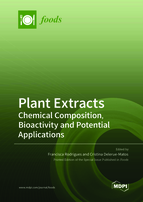Plant Extracts: Chemical Composition, Bioactivity and Potential Applications
A special issue of Foods (ISSN 2304-8158). This special issue belongs to the section "Nutraceuticals, Functional Foods, and Novel Foods".
Deadline for manuscript submissions: closed (28 February 2021) | Viewed by 64412
Special Issue Editors
Interests: plant extracts; green extraction techniques; bioactive compounds; antioxidants; functional food; cosmetics
Special Issues, Collections and Topics in MDPI journals
Interests: chromatographic determinations; electrochemistry; sensors/biosensors; sample preparation; environment and food control; environmental monitoring; contaminant detection; PAHs; pesticides; pharmaceuticals; heavy metals; allergens
Special Issues, Collections and Topics in MDPI journals
Special Issue Information
Dear Colleagues,
At present, the current society has demonstrated a high awareness and responsibility concerning environmental issues. In addition, the interest in bioactive compounds extracted from natural sources has increased due to their potential application as active ingredients in several industries, particularly the cosmetic, food, and pharmaceutical industries. Plants are rich sources of phenolic compounds that have been widely studied due to their health-promoting properties, namely antioxidant, anti-carcinogenic, and anti-inflammatory activities. Nevertheless, extraction is usually the limiting analytical step in the yield of bioactive compounds. From a green point of view, many extraction techniques have been employed as potential candidates to replace conventional methods, such as ultrasound-assisted extraction (UAE), pressurized liquid extraction (PLE), microwave-assisted extraction (MAE), supercritical fluid extraction (SFE), pulsed electric field extraction, and enzyme-assisted extraction.
This Special Issue will comprise research articles and reviews related to new trends in plant extraction and characterization. Manuscripts devoted to the extraction of plant by-products are also welcome. Particular attention will be given to manuscripts that not only chemically characterize but also evaluate using in vitro models the efficacy and safety of the extracts and suggest final applications.
Dr. Francisca Rodrigues
Prof. Cristin Delerue-Matos
Guest Editors
Manuscript Submission Information
Manuscripts should be submitted online at www.mdpi.com by registering and logging in to this website. Once you are registered, click here to go to the submission form. Manuscripts can be submitted until the deadline. All submissions that pass pre-check are peer-reviewed. Accepted papers will be published continuously in the journal (as soon as accepted) and will be listed together on the special issue website. Research articles, review articles as well as short communications are invited. For planned papers, a title and short abstract (about 100 words) can be sent to the Editorial Office for announcement on this website.
Submitted manuscripts should not have been published previously, nor be under consideration for publication elsewhere (except conference proceedings papers). All manuscripts are thoroughly refereed through a single-blind peer-review process. A guide for authors and other relevant information for submission of manuscripts is available on the Instructions for Authors page. Foods is an international peer-reviewed open access semimonthly journal published by MDPI.
Please visit the Instructions for Authors page before submitting a manuscript. The Article Processing Charge (APC) for publication in this open access journal is 2900 CHF (Swiss Francs). Submitted papers should be well formatted and use good English. Authors may use MDPI's English editing service prior to publication or during author revisions.
Keywords
- plants
- green extraction techniques
- bioactive compounds
- safety
- cosmetics
- nutraceutical industry








